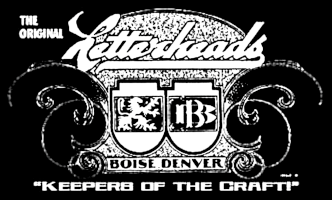Posted by Mike Jackson on May 01, 2003
We had a couple of occasions to want to protect odd shaped areas on our glass art pieces. We did 12 of each sign, so the process had to work as easy as possible. Doing a One-Off piece sometimes presents some additional issues, but you can usually spend a little longer solving the problem if you only have to go through the ordeal one time. When you do a bunch, the process needs to go smoothly.
The issue on this sign was the four larger ornaments in the corners. The bright lines for the rest of the border design were filled with copper varigated leaf and white gold. The outside border was painted black as you can see. We wanted to airbrush a blended background over the entire center section once the lettering and graphics area was finished. But still, we needed to protect the four corners for the pearl or abalone (last step).
As always we did some tests on scrap pieces. We tried cutting small squares of static cling material, but I was never really confident they would hold while I airbrushed. I didn't try the shellac process, which probably would have worked. We also tried painting Grip-Flex stencil, but since it is water based, it kept crawling. Seems it pulled some of the paint off on our test pieces, too. About that time, Rick Sacks sent us a little "Mud" masking from an old jar he had at his shop. We tried that on some goofy little test pieces, but that material is too slimy and not really made for the process.
(In the 50's, you would hand letter the mud masking on a white metal can or sign background, probably over a pounced pattern, then spray over it with laquer. The mud was about 80% glycerin which would not dry, would not let the laquer stick to the surface, and would wash off with water once the laquer dried. This worked good for red sign backgrounds when they didn't want brush strokes...it was also before the common use of transmask or grip flex stencil materials)
We ended up using Windsor Newton Liquid Frisket, though that stuff isn't the friendliest product to paint with. It ruins brushes pretty fast, too. Mark Oatis suggested the Windsor Newton maskoid, along with Glawson's approval. There are numerous brands of liquid maskoid out there, and it is probably worth testing the process on some scraps or test pieces before actually committing to doing it on a real piece. We were usually working over angel gilded panels with Dekor backup. I don't think I would try painting maskoid over larger letters. It took a couple of coats.
Hope this helps.
Mike Jackson
 Denver Chapter of the Letterheads
Denver Chapter of the Letterheads